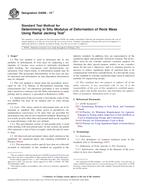Potrebujeme váš súhlas na využitie jednotlivých dát, aby sa vám okrem iného mohli ukazovať informácie týkajúce sa vašich záujmov. Súhlas udelíte kliknutím na tlačidlo „OK“.
ASTM D4506-13e1
Standard Test Method for Determining In Situ Modulus of Deformation of Rock Mass Using Radial Jacking Test (Includes all amendments And changes 10/13/2021).
Automaticky preložený názov:
Štandardná skúšobná metóda pre stanovenie in situ modulu deformácie horninového masívu radiálne Zdvíhanie test
NORMA vydaná dňa 1.11.2013
Informácie o norme:
Označenie normy: ASTM D4506-13e1
Poznámka: NEPLATNÁ
Dátum vydania normy: 1.11.2013
Kód tovaru: NS-27515
Počet strán: 7
Približná hmotnosť: 21 g (0.05 libier)
Krajina: Americká technická norma
Kategória: Technické normy ASTM
Kategórie - podobné normy:
Zemní práce. Hloubicí práce. Budování základů. Podzemní práce
Anotácia textu normy ASTM D4506-13e1 :
Keywords:
discontinuities, in situ stress, loading tests, radial jacking test, rock, pressure, ICS Number Code 93.020 (Earth works. Excavations. Foundation construction. Underground works)
Doplňujúce informácie
| Significance and Use | ||||||||
|
5.1 In this test method a volume of rock large enough to take into account the influence of discontinuities on the properties of the rock mass is loaded. This test method should be used when values are required which represent the true rock mass properties more closely than can be obtained through less expensive uniaxial jacking tests or other procedures. 1.1 This test method is used to
determine the in situ modulus of deformation of rock mass by
subjecting a test chamber of circular cross section to uniformly
distributed radial loading; the consequent rock displacements are
measured, from which elastic or deformation moduli may be
calculated. The anisotropic deformability of the rock can also be
measured and information on time-dependent deformation may be
obtained.
1.2 This test method is based upon the procedures developed by the U.S. Bureau of Reclamation featuring long extensometers (1).2 An alternative procedure is also available and is based on a reference bar 1.3 Application of the test results is beyond the scope of this test method, but may be an integral part of some testing programs. 1.4 The values stated in inch-pound units are to be regarded as standard. The values given in parentheses are mathematical conversions to SI units that are provided for information only and are not considered standard. Reporting of test results in units other than SI shall not be regarded as nonconformance with this test method. 1.4.1 The gravitational system of inch-pound units is used when dealing with inch-pound units. In this system, the pound (lbf) represents a unit of force (weight), while the unit for mass is slugs. 1.5 All observed and calculated values shall conform to the guidelines for significant digits and rounding established in Practice D6026. 1.5.1 The procedures used to specify how data are collected/recorded or calculated, in this standard are regarded as the industry standard. In addition, they are representative of the significant digits that generally should be retained. The procedures used do not consider material variation, purpose for obtaining the data, special purpose studies, or any considerations for the user’s objectives; and it is common practice to increase or reduce significant digits of reported data to be commensurate with these considerations. It is beyond the scope of this standard to consider significant digits used in analytical methods for engineering design. 1.6 This standard does not purport to address all of the safety concerns, if any, associated with its use. It is the responsibility of the user of this standard to establish appropriate safety and health practices and determine the applicability of regulatory limitations prior to use. |
||||||||
| 2. Referenced Documents | ||||||||
|
Podobné normy:
Historická
1.11.2012
Historická
1.9.2007
Historická
1.1.2008
Historická
1.2.2014
Historická
1.1.2012
Historická
1.2.2008
Odporúčame:
Aktualizácia technických noriem
Chcete mať istotu, že používate len platné technické normy?
Ponúkame Vám riešenie, ktoré Vám zaistí mesačný prehľad o aktuálnosti noriem, ktoré používate.
Chcete vedieť viac informácií ? Pozrite sa na túto stránku.



 ASTM D4186/D4186M-12..
ASTM D4186/D4186M-12.. ASTM D421-85(2007)..
ASTM D421-85(2007).. ASTM D4219-08
ASTM D4219-08 ASTM D4220/D4220M-14..
ASTM D4220/D4220M-14.. ASTM D4223/D4223M-12..
ASTM D4223/D4223M-12.. ASTM D425-88(2008)..
ASTM D425-88(2008)..
 Cookies
Cookies
